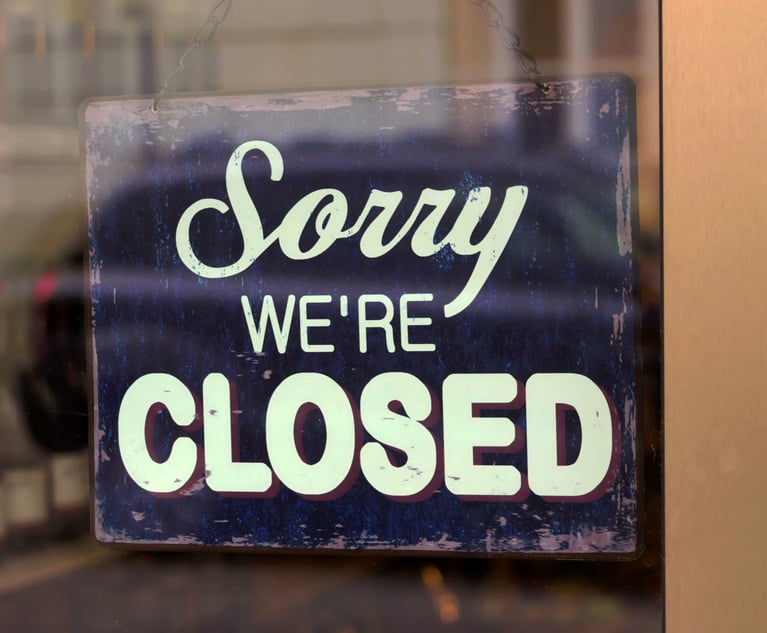The Case for a Comprehensive Information Governance Policy
If you're outside counsel and you've been hired because of the possibility of a future lawsuit, you need to seriously consider if your client's preservation obligations have already been triggered.
June 17, 2020 at 12:30 PM
5 minute read
 Todd Heffner of Jones Walker. (Courtesy photo)
Todd Heffner of Jones Walker. (Courtesy photo)Modern technology has made it easier than ever to hold onto vast amounts of documents and information, and many organizations are doing this without even first considering whether they should hold on to that information. And beyond the storage costs, there can be far greater increased costs. These include the risks of data breaches, recordkeeping compliance penalties, and those difficult to quantify, but ever-present, soft costs associated with so much information, such as increased time spent searching for particular items and increased eDiscovery costs. This article will explore the need for information governance, the basic idea behind it, and conclude with a brief discussion of legal holds.
One of the simplest explanations for why organizations will hold onto so much information—and why an information governance policy is needed—is to understand the individual decision makers within an organization and their motivations. An individual faced with the question of disposing of something or keeping it must decide between one option with potentially large risks and another option with none. If something is disposed of, it could potentially be needed for business, regulatory or other reasons further down the road. To know whether the information is needed for one of these purposes may require a somewhat lengthy investigation or series of emails. Alternatively, the document can simply be kept—a decision that takes almost no time and likely uses a negligible amount of storage space. But now imagine every single person across an entire organization making the same calculus, day after day, and year after year. Simply put, an organization's "policy" should not be based on an individual's fear of being the one who deleted something they shouldn't have.
Organizations need comprehensive information governance programs to combat having too much information. To establish one is an organization-wide initiative that needs to include representatives from all of a company's stakeholders, including business units, IT, legal, HR, records management, and executive leadership. The overall goals are to:
- Decide what can be disposed of, what needs to be kept, where to keep it and for how long;
- Develop procedures to actually put into action those decisions; while
- Be able to respond efficiently and effectively to legal holds, subpoenas, and the unexpected.
As part of developing an information governance program, it helps, at first, to overgeneralize everything into two types of decisions. First, some decisions for what to keep and for how long are straightforward because the decisions are dictated by various regulations. Some apply to every organization, while others can vary considerably depending on the industry. Examples of items in these categories include tax returns, or information required to be maintained under Sarbanes-Oxley, HIPAA, or the Fair Labor Standards Act. Second, and less straightforward, is information whose retention or destruction is more akin to a business decision, where the decision hinges on balancing the long-term value of information against its potential costs. A more detailed discussion of the factors to consider when making these types of decisions is beyond the scope of this article.
Once a policy is in place, it is important that it be capable of being suspended if a legal preservation obligation emerges—commonly referred to as a legal hold. There is no one-size-fits-all rule that can be applied to determine when the hold obligation is triggered (short of the super-obvious: a lawsuit being filed), but :
- Educating the organization on the standard applied by courts is helpful (more below); and
- There is one decent rule of thumb: if you're in-house counsel and you're considering law firms to hire for a matter, you need to seriously consider if your preservation obligations have already been triggered, or if you're outside counsel and you've been hired because of the possibility of a future lawsuit, you need to seriously consider if your client's preservation obligations have already been triggered. To be clear, this rule of thumb does not override the legal standard.
The legal standard for preservation can kick in before a lawsuit is even filed. The duty to preserve may arise earlier than the commencement of litigation if there is "reasonable anticipation" of litigation or it is "reasonably foreseeable." The standard is objective: would a reasonable party in the same circumstances reasonably foresee litigation (not whether the party itself foresaw litigation).
If you want to read more about information governance and legal holds (and who wouldn't?!), consider these three resources from The Sedona Conference:
- The Sedona Conference, Commentary on Information Governance, Second Edition, 20 Sedona Conf. J. 95 (2019);
- The Sedona Conference, Commentary on Defensible Disposition, Second Edition, 20 Sedona Conf. J. 179 (2019); and
- The Sedona Conference, Commentary on Legal Holds, Second Edition: The Trigger & The Process, 20 Sedona Conf. J. 341 (2019).
Todd Heffner is a construction litigator and eDiscovery specialist with Jones Walker in Atlanta.
This content has been archived. It is available through our partners, LexisNexis® and Bloomberg Law.
To view this content, please continue to their sites.
Not a Lexis Subscriber?
Subscribe Now
Not a Bloomberg Law Subscriber?
Subscribe Now
NOT FOR REPRINT
© 2025 ALM Global, LLC, All Rights Reserved. Request academic re-use from www.copyright.com. All other uses, submit a request to [email protected]. For more information visit Asset & Logo Licensing.
You Might Like
View All
A Plan Is Brewing to Limit Big-Dollar Suits in Georgia—and Lawyers Have Mixed Feelings
10 minute read

Law Firms Mentioned
Trending Stories
- 1Uber Files RICO Suit Against Plaintiff-Side Firms Alleging Fraudulent Injury Claims
- 2The Law Firm Disrupted: Scrutinizing the Elephant More Than the Mouse
- 3Inherent Diminished Value Damages Unavailable to 3rd-Party Claimants, Court Says
- 4Pa. Defense Firm Sued by Client Over Ex-Eagles Player's $43.5M Med Mal Win
- 5Losses Mount at Morris Manning, but Departing Ex-Chair Stays Bullish About His Old Firm's Future
Who Got The Work
J. Brugh Lower of Gibbons has entered an appearance for industrial equipment supplier Devco Corporation in a pending trademark infringement lawsuit. The suit, accusing the defendant of selling knock-off Graco products, was filed Dec. 18 in New Jersey District Court by Rivkin Radler on behalf of Graco Inc. and Graco Minnesota. The case, assigned to U.S. District Judge Zahid N. Quraishi, is 3:24-cv-11294, Graco Inc. et al v. Devco Corporation.
Who Got The Work
Rebecca Maller-Stein and Kent A. Yalowitz of Arnold & Porter Kaye Scholer have entered their appearances for Hanaco Venture Capital and its executives, Lior Prosor and David Frankel, in a pending securities lawsuit. The action, filed on Dec. 24 in New York Southern District Court by Zell, Aron & Co. on behalf of Goldeneye Advisors, accuses the defendants of negligently and fraudulently managing the plaintiff's $1 million investment. The case, assigned to U.S. District Judge Vernon S. Broderick, is 1:24-cv-09918, Goldeneye Advisors, LLC v. Hanaco Venture Capital, Ltd. et al.
Who Got The Work
Attorneys from A&O Shearman has stepped in as defense counsel for Toronto-Dominion Bank and other defendants in a pending securities class action. The suit, filed Dec. 11 in New York Southern District Court by Bleichmar Fonti & Auld, accuses the defendants of concealing the bank's 'pervasive' deficiencies in regards to its compliance with the Bank Secrecy Act and the quality of its anti-money laundering controls. The case, assigned to U.S. District Judge Arun Subramanian, is 1:24-cv-09445, Gonzalez v. The Toronto-Dominion Bank et al.
Who Got The Work
Crown Castle International, a Pennsylvania company providing shared communications infrastructure, has turned to Luke D. Wolf of Gordon Rees Scully Mansukhani to fend off a pending breach-of-contract lawsuit. The court action, filed Nov. 25 in Michigan Eastern District Court by Hooper Hathaway PC on behalf of The Town Residences LLC, accuses Crown Castle of failing to transfer approximately $30,000 in utility payments from T-Mobile in breach of a roof-top lease and assignment agreement. The case, assigned to U.S. District Judge Susan K. Declercq, is 2:24-cv-13131, The Town Residences LLC v. T-Mobile US, Inc. et al.
Who Got The Work
Wilfred P. Coronato and Daniel M. Schwartz of McCarter & English have stepped in as defense counsel to Electrolux Home Products Inc. in a pending product liability lawsuit. The court action, filed Nov. 26 in New York Eastern District Court by Poulos Lopiccolo PC and Nagel Rice LLP on behalf of David Stern, alleges that the defendant's refrigerators’ drawers and shelving repeatedly break and fall apart within months after purchase. The case, assigned to U.S. District Judge Joan M. Azrack, is 2:24-cv-08204, Stern v. Electrolux Home Products, Inc.
Featured Firms
Law Offices of Gary Martin Hays & Associates, P.C.
(470) 294-1674
Law Offices of Mark E. Salomone
(857) 444-6468
Smith & Hassler
(713) 739-1250







